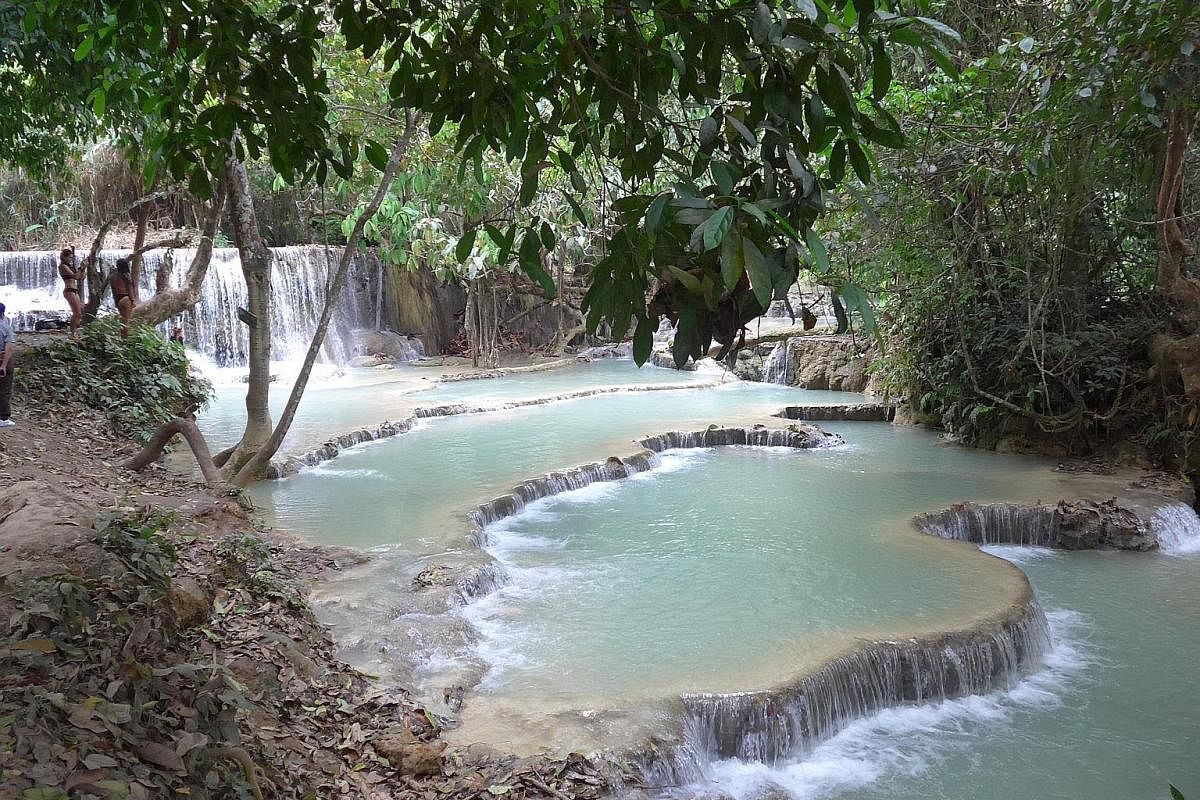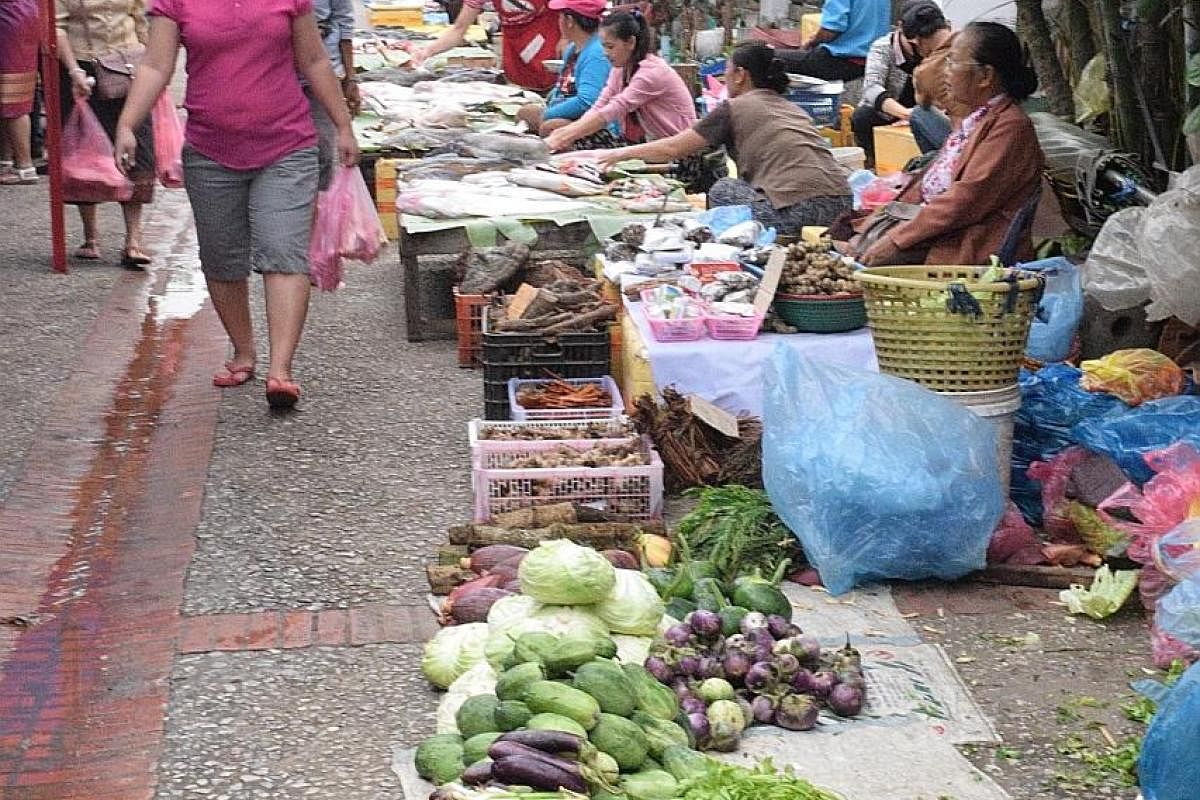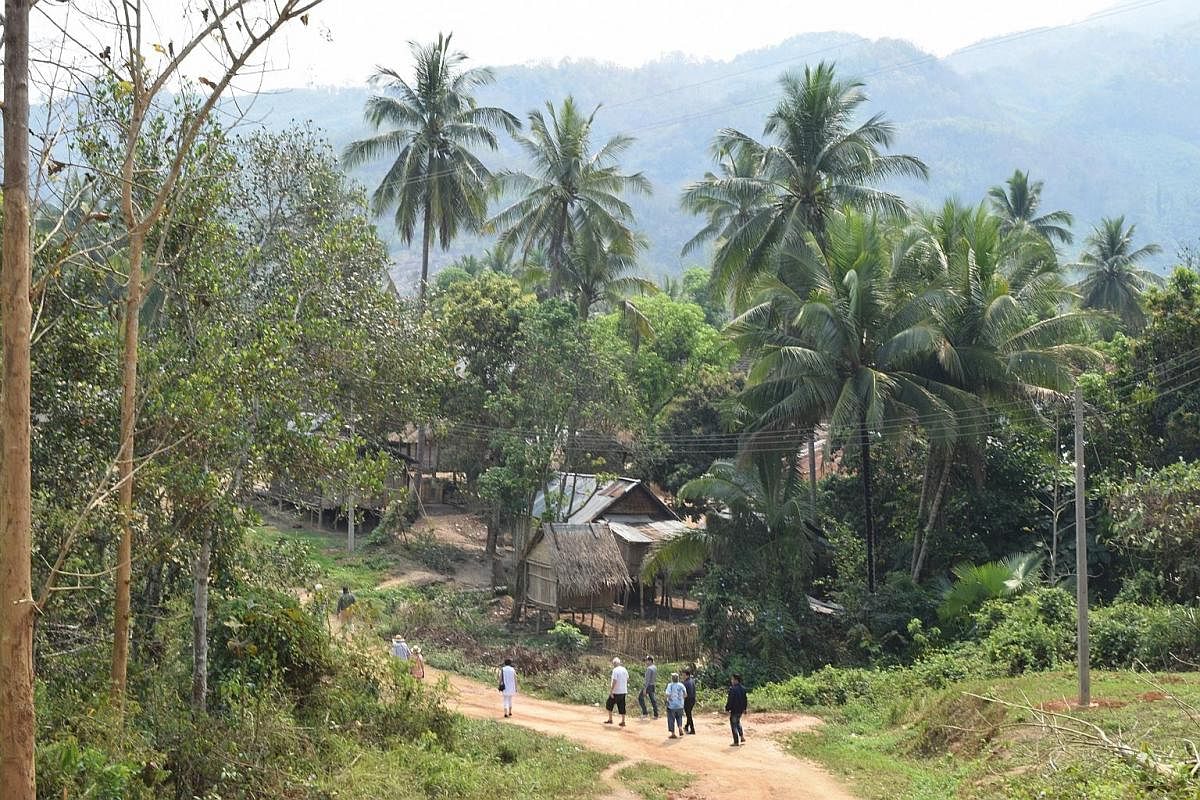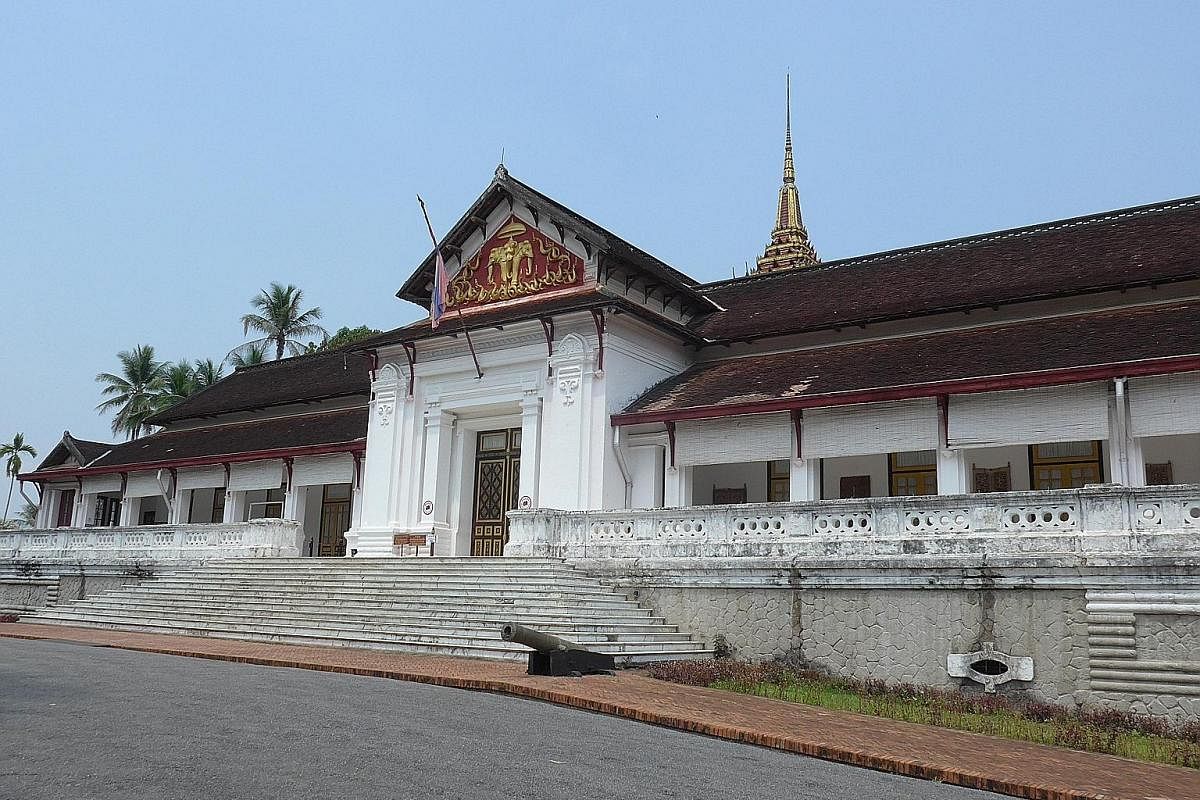-

GETTING THEREI fly on Thai Airways from Singapore to Chiang Mai via Bangkok. Then a five-hour mini-bus transfer takes me to Chiang Saen on the Thai-Laos border to board the Laos Pandaw for my 11-day Mekong cruise.
TRAVEL TIPS
•Early birds will see the Mekong come to life. As the sun rises, observe fishermen casting nets from their boats and hauling them in with their catch. Occasionally, you will spy herons, egrets and other birds feeding. Tea, coffee and croissants are served on the upper deck of the Laos Pandaw from 6am, an hour before breakfast.
••It can get surprisingly chilly on board in the morning before 11am and in the evening, so pack a sweater or jacket.
• Cycling in tranquil Luang Prabang is a delight and there are bicycles on board that you can borrow to explore the city's back streets.
•Laos is a conservative country, so women should avoid wearing shorts and skimpy tops when visiting temples and monasteries and when taking part in the alms-giving ritual in Luang Prabang. Men are expected to wear long pants when visiting Buddhist sites.
Down the mighty Mekong
A riverboat traverses Laos, taking passengers through forested landscapes to tribal villages and the heritage city of Luang Prabang





A riverine journey in Laos is ideal for observing local life close-up and reaching difficult-to-access villages along the mighty Mekong River - without the discomfort of bumpy, potholed road travel that I experienced on previous visits.
I am on board the Laos Pandaw, a stylish riverboat reminiscent of the quaint paddle steamers of the past. Indeed, the Laos Pandaw has been patterned after the Scottish-built paddle steamers used by the Irrawaddy Flotilla Company in Burma (now Myanmar) to transport goods and people on the Irrawaddy River for nearly 100 years until 1948.
Elegantly furnished with gleaming brass fixtures and polished teak wood decks, the 10-cabin Laos Pandaw is redolent of the romance of cruising in a bygone era.
What adds to the sense of escapade is the rare itinerary: an 11-day cruise across a vast portion of Laos, the first since the pre-war years when the country was part of French Indochina.
The 900km journey from Chiang Saen on the Thai-Laos border to the Laotian capital of Vientiane traverses a mountainous interior clad in pristine jungle, where few travellers have ventured.
Scenes of natural beauty are assured, but floating down this part of the Mekong is anything but placid. Rapids, gorges and waterfalls make navigating this upper section of the river a test of true skill, which the Laos Pandaw and her skipper handle with dexterity.
At 4,350km in length, the Mekong is the world's 12th longest river and South-east Asia's longest. It begins its journey in the Tibetan plateau, running tumultuously through China's Yunnan province, Myanmar, Laos, Thailand and Cambodia before flowing out through the many-fingered Mekong Delta in Vietnam into the South China Sea.
It is a life force of about 60 million people, who depend on it for food, trade and transport. In Laos itself, the river flows 1,600km across the country, from north to south.
Along the banks of the river and its tributaries, indigenous tribes, living much as they have done for centuries, grow rice and harvest the fish-rich waters.
These tribes - and the unspoilt jungle interior - are the essence of the Mekong, making the riverine journey an experience to remember.
I begin my journey in Chiang Mai, Thailand, where I join my fellow passengers - from Canada, Australia, the United States and Sweden - in a five-hour mini-bus transfer to board the Laos Pandaw in Chiang Saen. She is anchored at the evocatively named Golden Triangle, where the borders of three countries - Laos, Myanmar and Thailand - meet.
COCKTAILS AND ADVENTURE
Our first night on board sets the rhythm for the rest of the week - complimentary cocktails at 6.30pm on the upper deck, followed by a briefing on the next day's activities, then dinner at 7.30pm.
On some nights, there are cultural evenings, such as the Thai dance performances to welcome us in Chiang Saen; the release of candle-lit sky lanterns for good luck on a magical barbecue night on a sandbank; and the baci ceremony to celebrate our arrival in Laos.
The spiritual ritual of baci begins with soulful chants by a singing group, led by a community elder, and is topped off with the tying of white strings around our wrists for good luck.
Our cruise begins in earnest the next day, as we cast off after clearing immigration at the Golden Triangle checkpoint to exit Thailand for our foray into Laos.
Our first stop is Houy Xay, where we are intrigued by a lively street market brimming with fruit and vegetables and exotic jungle produce that are local favourites - bee larvae, beetles, monitor lizards and squirrels. We also visit the Buddhist temple of Wat Jom Khaw, set on a hill overlooking the Mekong.
Until we reach Luang Prabang, the mid-way point of our cruise when the Mekong swings inland, we are flanked by Thailand on one side and Laos on the other. This is the busiest part of the river, crisscrossed by long, narrow speedboats ferrying passengers and bulky cargo boats carrying goods as they ply between Thai and Laotian towns across the water divide.
FEROCIOUS UPPER MEKONG
Early in our journey, we witness how ferocious the upper Mekong can be, making it one of the world's trickiest rivers to navigate. Protruding rocks, sandbanks and fast-flowing rapids make sailing on the river akin to manoeuvring around an obstacle course.
But our veteran Laotian captain Houm Phan and his first mate Boun guide the flat-bottomed Laos Pandaw effortlessly into clear passageways.
After the initial excitement, we experience a more tranquil Mekong with inky-blue forest-clad mountains in the distance and the occasional village in the foreground surrounded by young teak trees, corn fields, banana groves, rice paddies and vegetable gardens on sloping banks.
Visiting tribal villages and exploring the countryside while gaining an insight into the local communities' way of life is one of the main features of our cruise. Three, in particular, stand out.
The first is Ban Huay Phalam, belonging to the Khmu hilltribe, the largest minority ethnic group in this northern part of Laos. The cheroot-smoking Khmu have their own dialect and still retain many customs, which include living in wooden houses on stilts within an enclosure, outside of which are rice granaries, also on stilts to ward off rats.
Another is Ban Pak Yun, where three different tribal groups - the Lao Lowlander, Khmu and Hmong - live harmoniously together. Though set apart in separate enclaves, there is much intermingling and intermarriages among the tribes are not uncommon.
Then there is vibrant Ban Bor, known for its weaving tradition. Beneath almost every house on stilts is a wooden loom used to hand-weave scarves, cloth panels and wall hangings in silk and cotton, all proudly displayed for sale to visitors.
We visit its only school, its richly gilded temple and a distillery making the clear Lao-Lao liquor using fermented rice. Lao-Lao is too fiery to imbibe on its own, but is delicious when we taste it in our specially created cocktail back aboard the Laos Pandaw.
Leaving behind the tribal villages, we sail towards Luang Prabang, without doubt, the singular highlight of our Mekong expedition.
En route, we stop to visit the impressive upper and lower limestone caves of Pak Ou, carved out of a sheer limestone cliff. We are here to explore the naturally lit lower cave and a darkened upper cave not for their limestone formations, but to contemplate upon the 4,000 Buddha images placed there by pilgrims over centuries - a moving encounter, whatever one's religious bent.
A playful interlude with elephants from the All Lao Elephant Camp opposite the caves follows, as they mingle in our midst on a beach.
MOUNTAIN KINGDOM, COLONIAL CHARM
It is our stay in Luang Prabang, a Unesco World Heritage site, that is etched deeply in our minds. Nestled in a valley surrounded by lush highlands, the former mountain kingdom of Luang Prabang has more of the charm of a provincial town than the vibe of being one of Laos' largest cities.
We visit Wat Xieng Thong, the most historic Buddhist monastery in Laos and the sumptuous former Royal Palace, now a museum. Luang Prabang's last king, Sisavang Vong, who was installed as Laos' head of state by the French in 1946, lived in the palace before the capital was moved to Vientiane in 1975.
The best part of getting to know this city is to wander through its streets on foot. We admire the striking colonial French-Indochinese architecture. We also join the locals as they shop for their daily needs in the early morning market, trawl its famous night market for tribal textiles and handicrafts, and walk up the steep staircase to the 150m-high Mount Phousi to watch the sunset over the Mekong.
Taking in the sweeping views of the timeless river and surrounding plains dotted with temples and villages, it is clear that nothing has changed for generations.
To cap off our stay in this extraordinary city, we rise early on the day we leave to partake in the dawn ritual of alms-giving.
We perch on doll-size stools next to residents sitting by the road- side. Following their lead, we place dollops of sticky rice and sweet snacks into the bowls of saffron- robed monks who have stepped out from their temples to collect their one meal of the day.
It is then time to continue our journey down the Mekong, but, first, we make a detour to travel to Tat Kuang Si, 30 minutes by road, to explore its photogenic multi- tiered waterfall cascading down limestone outcrops into a series of aquamarine pools and to visit its centre for rehabilitating rescued moon bears and a butterfly breeding sanctuary.
Wandering through the jungle surrounds to discover the waterfalls is pure enchantment, with the gurgling cascades and clear pools peeking out amid deep green foliage.
Even the sanctuary for the moon bear, also known as the Asiatic black bear, an endangered species, is an oasis for reflection.
Nearly two dozen bears, rescued from bile farms where they were subjected to torturous ordeals to extract their bile for use in Chinese traditional medicine, now romp here freely, thanks to the charitable Free the Bears Fund.
MORE DRAMA, MORE TRANQUILLITY
From Luang Prabang, the Mekong swings southwards to flow some 400km before meeting the border with Thailand again.
For the last three days of our cruise until we reach Vientiane, we sail between Thailand on one side of the river and Laos on the other.
Our downriver course meets with a new obstacle: the Xayaburi dam, the first of 12 dams planned for the Mekong.
When completed in 2019, Laos hopes the Xayaburi dam will go towards fulfilling its hope of becoming the "big battery of Asia", when it can raise money for development by selling energy to neighbouring countries.
It is a controversial project that will see the displacement of villages along the path of the dams and the loss of livelihoods.
For vessels, moving from one part of the river to the other means having to negotiate a lock. It is very narrow and Laos Pandaw fits into it with just a few millimetres to spare.
We watch with bated breath as our ship inches her way in. Above us, workers look on as the lock slowly takes in water. When full, the gates ahead of us begin to open gradually; we are all on deck to witness the passage of the Laos Pandaw back into the river.
It is exhilarating as we exit the lock and are buoyed by the gushing waters of the Mekong as our ship is swept away hastily from the concrete dam walls to be enveloped by the serenity of the waterway again.
And just when we think we have left behind the thrills of navigating the Mekong, the river displays its ferocity again, before our arrival into Vientiane.
We are greeted with a dramatic landscape of jungle and mountains and a wild river. We hear the heavy cranking of the ship's powerful engines as our skipper adroitly works around the rapids, swerving the boat from side to side to avoid the jagged rocks rising out of a narrow channel.
It is over in an hour and we are rewarded with a smooth sail into French-influenced Vientiane, where we spend the next two days exploring the gilded temples of Wat Sisaket and Wat Prakeo and walking along its widest boulevard, Thanon Lan Xang, styled after Paris' Champs-Elysees and culminating in the Victory Monument - the Laotian version of the Arc de Triomphe.
Our cruise is a mere glimpse of the Mekong and the deep heart of Laos.
It has also been a moment to revel in the river's serene beauty and its wilder thrills - an adventure set within an elegant vessel.
•The writer was hosted by Pandaw River Expeditions.
Luxury on board a remodelled cargo boat
For travellers wishing to explore the remote upper Mekong in style, the Laos Pandaw has all the elements of comfort, with cosy airconditioned cabins - all ensuite and wood panelled - and full windows on the main deck.
The upper deck has an open dining area, where all meals are served, as well as a sun deck with a library and reading area furnished with wicker furniture. By the railings of the sun deck are deck chairs - a popular spot to sit and observe the passing scenery.
There is plenty of space on board and with a staff-to-guest ratio of one to one, service standards are high.
When returning from on-shore excursions, for instance, we are always greeted with chilled fruit juices or lemon tea and cold wet towels - refreshing after a humid day of exploration.
Lunch and dinner are a gourmet's delight, comprising a mix of Asian dishes and Continental fare. The salad buffet, housemade breads and cheese platter are a constant at all meals, which kick off with a starter, followed by a main course with a choice of meat, fish or vegetarian dish and rounded off with a dessert.
So there might be a platter of sushi or spinach and mushroom soup as starters; grilled marinated salmon, stuffed pork and cheese or roasted eggplant as main course selections; and peach upside-down cake as dessert.
What makes the Laos Pandaw special is that she has strong links to the Mekong. She was once a cargo barge belonging to skipper Houm Phan. He has sailed the Mekong for decades and had been operating his own cargo boat since 2000, making deliveries of cement and timber to China.
In January 2015, when Pandaw Cruises founder Paul Strachan had the idea of launching a cruise 10 months later, he actually had no ship yet. But the moment he sold out all cabins, panic set in and he knew he had to scout for a suitable ship.
On his reconnaissance trip to Laos, he booked to sail on the first cargo boat he saw - a 45m long and 8.8m wide barge belonging to Mr Houm. Impressed by the boat, which had two powerful 400hp engines to tackle the Mekong's swift waters, and by how she was handled, Mr Strachan managed to persuade Mr Houm to sell his barge to Pandaw Cruises and continue the link with his beloved boat by becoming the skipper.
The single-level wooden cargo boat was stripped bare and underwent a total makeover in eight months to add 10 cabins, a timber teak deck to create two levels, plus wooden panels and brass fixtures to achieve the old-world look.
The Laos Pandaw is operated by Pandaw Cruises, a pioneer in river cruising in off-beat places such as the Rajang in the heart of Borneo and the Irrawaddy, where it all began in 1995.
Pandaw Cruises set the trend again on the Mekong in November 2015, when it became the first to offer an itinerary between Vientiane and the Golden Triangle, at a time when only short cruises in the south and around Luang Prabang were available.
The Laos Pandaw cruises the Mekong every year from September to April. A second riverboat, the 14-cabin Champa Pandaw, has recently been added to double the number of cruises available.
True to the company's ethos of operating in hard-to-navigate rivers and remote destinations, a new four-day extension to China has now been added to the Laos Pandaw itinerary, with the boat sailing on the Upper Mekong to Jinghong in Yunnan province.
Pandaw Cruises has a fleet of 14 ships sailing in rivers in Myanmar, Vietnam, Cambodia, Laos and China. Prices start at US$3,600 (S$4,900) a person.
For more information and bookings, go to www.pandaw.com.
Join ST's Telegram channel and get the latest breaking news delivered to you.
A version of this article appeared in the print edition of The Sunday Times on August 20, 2017, with the headline Down the mighty Mekong. Subscribe
